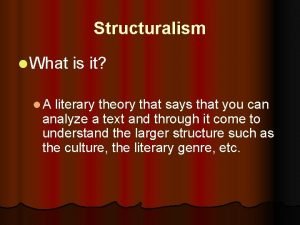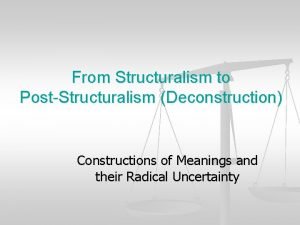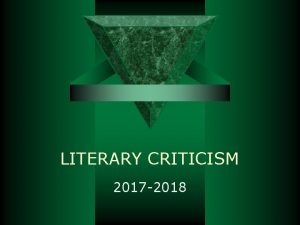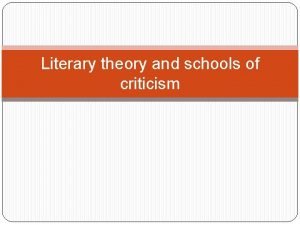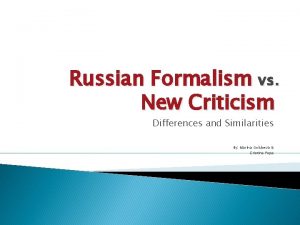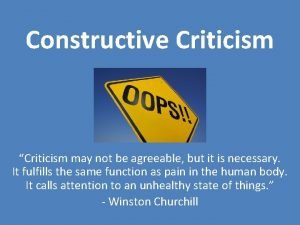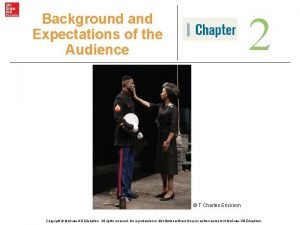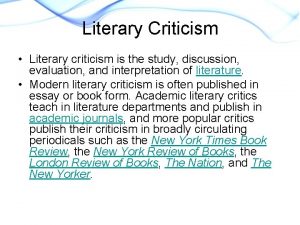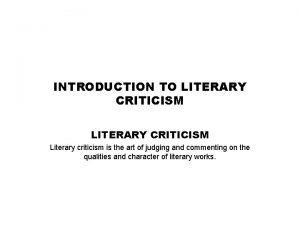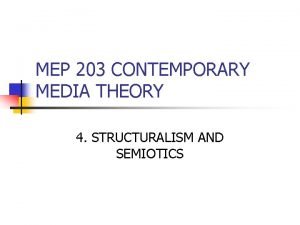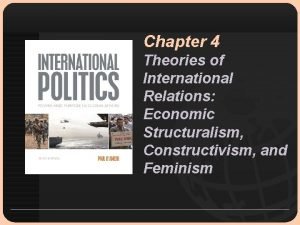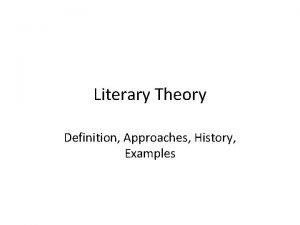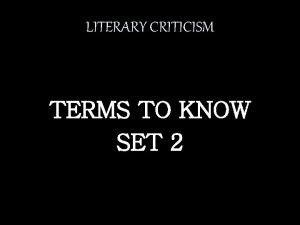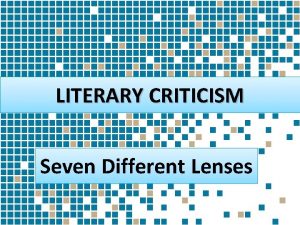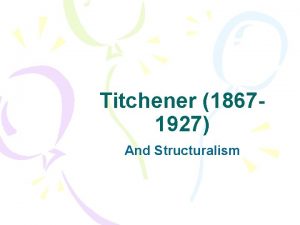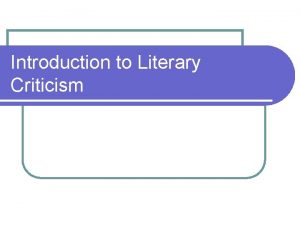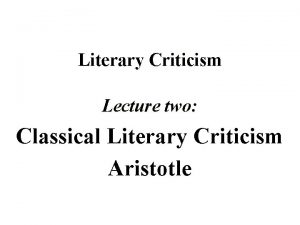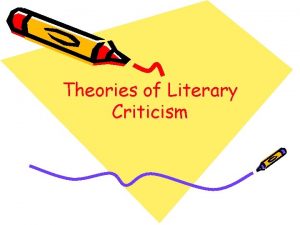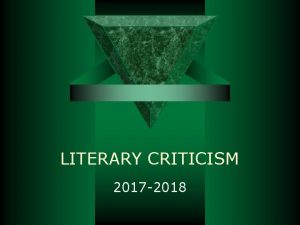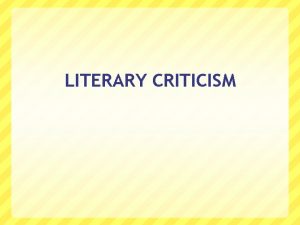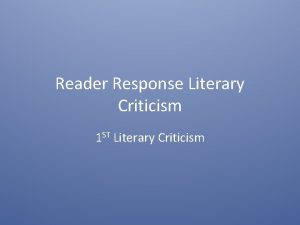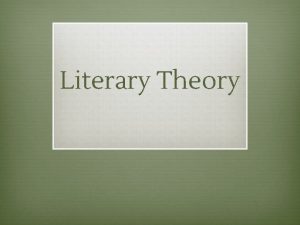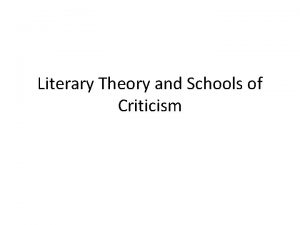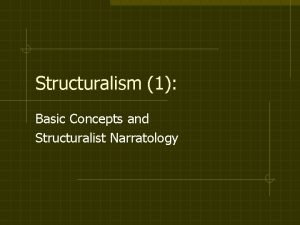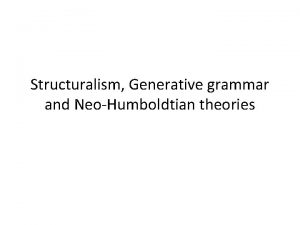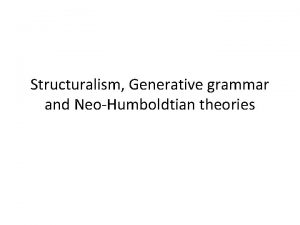Lecture 8 Structuralism Literary Criticism and Theory Deanship























- Slides: 23



Lecture 8 Structuralism Literary Criticism and Theory ﻋﻤﺎﺩﺓ ﺍﻟﺘﻌﻠﻢ ﺍﻹﻟﻜﺘﺮﻭﻧﻲ ﻭﺍﻟﺘﻌﻠﻴﻢ ﻋﻦ ﺑﻌﺪ Deanship of E-Learning and Distance Education [ ] ﺟﺎﻣﻌﺔ ﺍﻟﻤﻠﻚ ﻓﻴﺼﻞ King Faisal University

Structuralism v Structuralism in literature appeared in France in the 1960 s v. It continues the work of Russian Formalism in the sense that it does not seek to interpret literature; it seeks rather to investigate its structures. v. The most common names associated with structuralism are Roland Barthes, Tzvetan Todorov, Gerard Gennete, and A. j. Greimas. v The following lecture looks at one of the most influential contributions of structuralism to the study of literature: Gerard Gennete’s Discours du récit (Paris, 1972), translated into English as Narrative Discourse (1980). v. No other book has been so systematic and so thorough in analyzing the structures of literary discourse and narratology. ﻋﻤﺎﺩﺓ ﺍﻟﺘﻌﻠﻢ ﺍﻹﻟﻜﺘﺮﻭﻧﻲ ﻭﺍﻟﺘﻌﻠﻴﻢ ﻋﻦ ﺑﻌﺪ Deanship of E-Learning and Distance Education [ 4 ] ﺟﺎﻣﻌﺔ ﺍﻟﻤﻠﻚ ﻓﻴﺼﻞ King Faisal University

Narrative Discourse v Gennette analyzes three main aspects of the narrative discourse: ü Time: Order, Duration, Frequency ü Mood: Distance (Mimesis vs. Diegesis), Perspective (the question who sees? ) ü Voice: Levels of narration (the question who speaks? ) ﻋﻤﺎﺩﺓ ﺍﻟﺘﻌﻠﻢ ﺍﻹﻟﻜﺘﺮﻭﻧﻲ ﻭﺍﻟﺘﻌﻠﻴﻢ ﻋﻦ ﺑﻌﺪ Deanship of E-Learning and Distance Education [ 5 ] ﺟﺎﻣﻌﺔ ﺍﻟﻤﻠﻚ ﻓﻴﺼﻞ King Faisal University

Narrative Order v There are two forms of time in narrative: ü The time of the story: The time in which the story happens ü The time of the narrative: The time in which the story is told/narrated v “Narrative Order” is the relation between the sequencing of events in the story and their arrangement in the narrative. v. A narrator may choose to present the events in the order they occurred, that is, chronologically, or he can recount them out of order. Example: detective stories often begin with a murder that has to be solved. The events preceding the crime, along with the investigation that leads to the killer, are presented afterwards. The order in which the events occurred does not match the order in which they are presented in the narrative. ﻋﻤﺎﺩﺓ ﺍﻟﺘﻌﻠﻢ ﺍﻹﻟﻜﺘﺮﻭﻧﻲ ﻭﺍﻟﺘﻌﻠﻴﻢ ﻋﻦ ﺑﻌﺪ ﺟﺎﻣﻌﺔ ﺍﻟﻤﻠﻚ ﻓﻴﺼﻞ This mixing of temporal order produces a more gripping and complex plot (suspense). [ 6 ] Deanship of E-Learning and Distance Education King Faisal University

Narrative Order v. A narrator may choose to present the events in the order they occurred, that is, chronologically, or he can recount them out of order. Example: detective stories often begin with a murder that has to be solved. The events preceding the crime, along with the investigation that leads to the killer, are presented afterwards. The order in which the events occurred does not match the order in which they are presented in the narrative. This mixing of temporal order produces a more gripping and complex plot (suspense). ﻋﻤﺎﺩﺓ ﺍﻟﺘﻌﻠﻢ ﺍﻹﻟﻜﺘﺮﻭﻧﻲ ﻭﺍﻟﺘﻌﻠﻴﻢ ﻋﻦ ﺑﻌﺪ Deanship of E-Learning and Distance Education [ 7 ] ﺟﺎﻣﻌﺔ ﺍﻟﻤﻠﻚ ﻓﻴﺼﻞ King Faisal University

Time Zero v. The time of the story is, by definition, always chronological: Events as they happen: A – B – C – D – E – F (a chronological order) The time of the narrative is not necessarily chronological: Events as narrated: E – D – A – C – B – F (non-chronological) v. Time Zeros: is the point in time in which the narrator is telling his/her story. This is the narrator’s present, the moment in which a narrator is sitting and telling his/her story to an audience or to a reader, etc. Time Zero is the tome of the narration ﻋﻤﺎﺩﺓ ﺍﻟﺘﻌﻠﻢ ﺍﻹﻟﻜﺘﺮﻭﻧﻲ ﻭﺍﻟﺘﻌﻠﻴﻢ ﻋﻦ ﺑﻌﺪ Deanship of E-Learning and Distance Education [ 8 ] ﺟﺎﻣﻌﺔ ﺍﻟﻤﻠﻚ ﻓﻴﺼﻞ King Faisal University

Anachronies v Gennette calls all irregularities in the time of narration: Anachrobies. v Anachronies happen whenever a narrative stops the chronological order in order to bring events or information from the past (of the time zero) or from the future (of the time zero). ﻋﻤﺎﺩﺓ ﺍﻟﺘﻌﻠﻢ ﺍﻹﻟﻜﺘﺮﻭﻧﻲ ﻭﺍﻟﺘﻌﻠﻴﻢ ﻋﻦ ﺑﻌﺪ Deanship of E-Learning and Distance Education [ 9 ] ﺟﺎﻣﻌﺔ ﺍﻟﻤﻠﻚ ﻓﻴﺼﻞ King Faisal University

Anachronies Analepsis: The narrator recounts after the fact an event that took place earlier than the moment in which the narrative is stopped. Example (fictitious): I woke up in a good mood this morning. In my mind were memories of my childhood, when I was running in the fields with my friends after school. 2. Prolepsis: The narrator anticipates events that will occur after the point in time in which the story has stops. Example (fictitious): How will my travel to Europe affect me? My relationship with my family and friends will never be the same again. This is what will make me later difficult to live with. ﻋﻤﺎﺩﺓ ﺍﻟﺘﻌﻠﻢ ﺍﻹﻟﻜﺘﺮﻭﻧﻲ ﻭﺍﻟﺘﻌﻠﻴﻢ ﻋﻦ ﺑﻌﺪ Deanship of E-Learning and Distance Education [ 10 ] ﺟﺎﻣﻌﺔ ﺍﻟﻤﻠﻚ ﻓﻴﺼﻞ King Faisal University

Reach and Extent "An anachrony can reach into the past or the future, either more or less far from the "present" moment (that is, from the moment in the story when the narrative was interrupted to make room for the anachrony): this temporal distance we will name the anachrony's reach. The anachrony itself can also cover a duration of story that is more or less long: we will call this its extent" (Gennette, Narrative Discourse, 1980, p. 48). ﻋﻤﺎﺩﺓ ﺍﻟﺘﻌﻠﻢ ﺍﻹﻟﻜﺘﺮﻭﻧﻲ ﻭﺍﻟﺘﻌﻠﻴﻢ ﻋﻦ ﺑﻌﺪ Deanship of E-Learning and Distance Education [ 11 ] ﺟﺎﻣﻌﺔ ﺍﻟﻤﻠﻚ ﻓﻴﺼﻞ King Faisal University

The Function of Anachronies can have several functions in a narrative: v. Analepses often take on an explanatory role, developing a character's psychology by relating events from his past vprolepses can arouse the reader's curiosity by partially revealing facts that will surface later. v. These breaks in chronology may also be used to disrupt the classical novel's linear narrative. ﻋﻤﺎﺩﺓ ﺍﻟﺘﻌﻠﻢ ﺍﻹﻟﻜﺘﺮﻭﻧﻲ ﻭﺍﻟﺘﻌﻠﻴﻢ ﻋﻦ ﺑﻌﺪ Deanship of E-Learning and Distance Education [ 12 ] ﺟﺎﻣﻌﺔ ﺍﻟﻤﻠﻚ ﻓﻴﺼﻞ King Faisal University

Narrative Mood: Mimesis vs. Diegesis v Traditional criticism studied, under the category of mood, the question whether literature uses mimesis (showing) or diegesis (telling). v Since the function of narrative is not to give an order, express a wish, state a condition, etc. , but simply to tell a story and therefore to “report” facts (real or fictive), the indicative is its only mood. v In that sense, Genette says, all narrative is necessarily diegesis (telling). It can only achieve an illusion of mimesis (showing) by making the story real, alive and vivid. v No narrative can show or imitate the story it tells. All it can do is tell it in a manner that can try to be detailed, precise, alive, and in that way give more or less the illusion of mimesis (showing). Narration (oral or written) is a fact of language and language signifies without imitating. v Mimesis, for Gennete is only a form of diegesis, showing is only a form of telling. v It is more accurate to study the relationship of the narrative to the information it presents under the headings of: Distance and Perspective ﻋﻤﺎﺩﺓ ﺍﻟﺘﻌﻠﻢ ﺍﻹﻟﻜﺘﺮﻭﻧﻲ ﻭﺍﻟﺘﻌﻠﻴﻢ ﻋﻦ ﺑﻌﺪ Deanship of E-Learning and Distance Education [ 13 ] ﺟﺎﻣﻌﺔ ﺍﻟﻤﻠﻚ ﻓﻴﺼﻞ King Faisal University

Narrative Distance v The only imitation (mimesis) possible in literature is the imitation of words, where the exact words uttered can be repeated/reproduced/imitated. Otherwise, ALL narratives are narratives of events and here every narrative chooses to take a certain amount of distance from the information is narrates. v. Narrative of Events: Always a diegesis, that is, a transcription of the non-verbal into the verbal. üMimesis: maximum of information and a minimum of the informer. üDiegesis: a minimum of information and a maximum presence of the informer. ﻋﻤﺎﺩﺓ ﺍﻟﺘﻌﻠﻢ ﺍﻹﻟﻜﺘﺮﻭﻧﻲ ﻭﺍﻟﺘﻌﻠﻴﻢ ﻋﻦ ﺑﻌﺪ Deanship of E-Learning and Distance Education [ 14 ] ﺟﺎﻣﻌﺔ ﺍﻟﻤﻠﻚ ﻓﻴﺼﻞ King Faisal University

Narrative Distance Narrative of Words: The only form of mimesis that is possible (Three types): üNarrated speech: is the most distant and reduced (“I informed my mother of my decision to marry Albertine” [exact uttered speech]. üTransposed speech: in indirect style (“I told my mother that I absolutely had to marry Albertine” [mixture of uttered and narrated speech]. üReproduced speech: The most mimetic form is where the narrator pretends that the character is speaking and not the narrator: “I said to my mother: it is absolutely necessary that I marry Albertine. ” ﻋﻤﺎﺩﺓ ﺍﻟﺘﻌﻠﻢ ﺍﻹﻟﻜﺘﺮﻭﻧﻲ ﻭﺍﻟﺘﻌﻠﻴﻢ ﻋﻦ ﺑﻌﺪ Deanship of E-Learning and Distance Education [ 15 ] ﺟﺎﻣﻌﺔ ﺍﻟﻤﻠﻚ ﻓﻴﺼﻞ King Faisal University

Narrative Perspective v. Perspective is the second mode of regulating information. v. Traditional criticism, says Gennete, confuses two different issues (narrative voice and narrative perspective) under the question of “Point of View”: v. Gennete argues that a distinction should be made between narrative voice (the question “Who speaks? ”) and narrative perspective (the question “Who sees? ”). v. The one who perceives the events is not necessarily the one who tells the story of those events, and vice versa. ﻋﻤﺎﺩﺓ ﺍﻟﺘﻌﻠﻢ ﺍﻹﻟﻜﺘﺮﻭﻧﻲ ﻭﺍﻟﺘﻌﻠﻴﻢ ﻋﻦ ﺑﻌﺪ Deanship of E-Learning and Distance Education [ 16 ] ﺟﺎﻣﻌﺔ ﺍﻟﻤﻠﻚ ﻓﻴﺼﻞ King Faisal University

Focalization: Who Sees? Genette distinguishes three kinds of focalization: 1. Zero focalization: The narrator knows more than the characters. He may know the facts about all of the protagonists, as well as their thoughts and gestures. This is the traditional "omniscient narrator". 2. Internal focalization: The narrator knows as much as the focal character. This character filters the information provided to the reader, and the narrator does not and cannot access or report the thoughts of other characters. Focalization means, primarily, a limitation, a limit on the capacity of the narrator to “see” and “report. ” If the narrator wants to be seen as reliable, then he/she has to recognize and respect that he cannot be everywhere and know everything. ﻋﻤﺎﺩﺓ ﺍﻟﺘﻌﻠﻢ ﺍﻹﻟﻜﺘﺮﻭﻧﻲ ﻭﺍﻟﺘﻌﻠﻴﻢ ﻋﻦ ﺑﻌﺪ Deanship of E-Learning and Distance Education [ 17 ] ﺟﺎﻣﻌﺔ ﺍﻟﻤﻠﻚ ﻓﻴﺼﻞ King Faisal University

Focalization: Who Sees? 3. External focalization: The narrator knows less than the characters. He acts a bit like a camera lens, following the protagonists' actions and gestures from the outside; he is unable to guess their thoughts. Again, there is restriction. ﻋﻤﺎﺩﺓ ﺍﻟﺘﻌﻠﻢ ﺍﻹﻟﻜﺘﺮﻭﻧﻲ ﻭﺍﻟﺘﻌﻠﻴﻢ ﻋﻦ ﺑﻌﺪ Deanship of E-Learning and Distance Education [ 18 ] ﺟﺎﻣﻌﺔ ﺍﻟﻤﻠﻚ ﻓﻴﺼﻞ King Faisal University

Levels of narration: Who Speaks? v Genette systematizes the varieties of narrators according to purely formal criteria: Their structural position with respect to the story/events and the different narrative/enunciative levels of the work. The two criteria he uses result in the fourfould characterization of narrators into extradiegetic / intradiegetic on one hand, and homodiegetic / heterodiegetic on the other. Note: Do not confuse [in fiction] the narrating instance with the instance of writing, the [fictional] narrator [sender] with the [real] author, or the [fictional] recipient [receiver, addressee of the [fictive] narrative with the [real] reader of the work. ﻋﻤﺎﺩﺓ ﺍﻟﺘﻌﻠﻢ ﺍﻹﻟﻜﺘﺮﻭﻧﻲ ﻭﺍﻟﺘﻌﻠﻴﻢ ﻋﻦ ﺑﻌﺪ Deanship of E-Learning and Distance Education [ 19 ] ﺟﺎﻣﻌﺔ ﺍﻟﻤﻠﻚ ﻓﻴﺼﻞ King Faisal University

Levels of narration: Who Speaks? v From the point of view of time, there are four types of narrating: v SUBSEQUENT: The classical (most frequent) position of the past-tense narrative. v PRIOR: Predictive narrative, generally in the future tense (dreams, prophecies) [this type of narrating is done with less frequency than any other] v SIMULTANEOUS: Narrative in the present contemporaneous with the action (this is the simplest form of narrating since the simultaneousness of the story and the narrating eliminates any sort of interference or temporal game). v INTERPOLATED: Between the moments of the action (this is the most complex) [e. g. , epistolary novels] ﻋﻤﺎﺩﺓ ﺍﻟﺘﻌﻠﻢ ﺍﻹﻟﻜﺘﺮﻭﻧﻲ ﻭﺍﻟﺘﻌﻠﻴﻢ ﻋﻦ ﺑﻌﺪ Deanship of E-Learning and Distance Education [ 20 ] ﺟﺎﻣﻌﺔ ﺍﻟﻤﻠﻚ ﻓﻴﺼﻞ King Faisal University

Levels of narration: Who Speaks? Homodiegetic Narrator: a story in which the narrator is present in the story he narrates Heterodiegetic Narrator: a story in which the narrator is absent from the story he narrates Extradiegetic Narrative: The narrator is superior, in the sense of being at least one level higher than the story world, and hence has a good or virtually complete knowledge of the story he narrates. Intradiegetic Narrative: the narrator is immersed within the same level as that of the story world, and has limited or incomplete knowledge of the story he narrates. . ﻋﻤﺎﺩﺓ ﺍﻟﺘﻌﻠﻢ ﺍﻹﻟﻜﺘﺮﻭﻧﻲ ﻭﺍﻟﺘﻌﻠﻴﻢ ﻋﻦ ﺑﻌﺪ Deanship of E-Learning and Distance Education [ 21 ] ﺟﺎﻣﻌﺔ ﺍﻟﻤﻠﻚ ﻓﻴﺼﻞ King Faisal University

Sources Gerard Gennette, The Narrative Discourse, trans. Jane E. Lewin, Foreword by Jonathan Culler (Ithaca, NY: Cornell University Press), 1983. Jonathan Culler, Structuralist Poetics: Structuralism, Linguistics and the Study of Literature (London: Routledge), 1975. ﻋﻤﺎﺩﺓ ﺍﻟﺘﻌﻠﻢ ﺍﻹﻟﻜﺘﺮﻭﻧﻲ ﻭﺍﻟﺘﻌﻠﻴﻢ ﻋﻦ ﺑﻌﺪ Deanship of E-Learning and Distance Education [ 22 ] ﺟﺎﻣﻌﺔ ﺍﻟﻤﻠﻚ ﻓﻴﺼﻞ King Faisal University

 Structuralism
Structuralism Structuralism literary criticism
Structuralism literary criticism What is post structuralism in literary criticism
What is post structuralism in literary criticism Differance
Differance Structuralist/formalist criticism example
Structuralist/formalist criticism example French post structuralism
French post structuralism Schools of criticism
Schools of criticism Approach that relies heavily on the author and his world
Approach that relies heavily on the author and his world Formalism/new criticism
Formalism/new criticism Psychological critics
Psychological critics What is a critical lens
What is a critical lens The difference between criticism and constructive criticism
The difference between criticism and constructive criticism Biblical criticism is not a form of historical criticism.
Biblical criticism is not a form of historical criticism. Descriptive criticism vs prescriptive criticism
Descriptive criticism vs prescriptive criticism 01:640:244 lecture notes - lecture 15: plat, idah, farad
01:640:244 lecture notes - lecture 15: plat, idah, farad Feminist criticism example
Feminist criticism example Advantages and disadvantages of literary criticism
Advantages and disadvantages of literary criticism Mythological literary criticism
Mythological literary criticism Structuralism media theory
Structuralism media theory Constructivism vs structuralism
Constructivism vs structuralism Characteristics of renaissance criticism
Characteristics of renaissance criticism Literary approach definition
Literary approach definition Periods of literary criticism
Periods of literary criticism Archetypal lens questions
Archetypal lens questions
